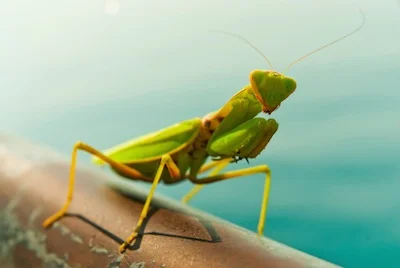A praying mantis is an insect.
It holds it legs up and looks like it is praying.
Their colours and patterns help them hide.
They eat other insects.
There are lots of different kinds of praying mantis.
What is a praying mantis?
Praying mantis on a plant ©Getty
Praying mantises are a small part of a larger group or carnivorous (meat -eating) insects called mantids.
There are about 2,000 different species (kinds) of mantids. The biggest are over 15 cm long and the smallest are about 1 cm long.
Mantids are found in warm to hot places in most continents of the world.
The praying mantis gets its name from the way it holds its front forelegs up as though it is praying.
Body
The front legs of the praying mantis have rows of sharp spines which are used to grip prey.
Mantids have a triangular shaped head. ©Getty
Mantids have a triangular shaped head with a large eye on each side that can see the slightest movement up to 35metres away. It is the only insect that can turn its head 180º, or a half circle. It has excellent hearing.
Mantids have straight leathery wings and powerful jaws. Mantids fly mostly at night.
Mantids depend on camouflage (cam-oo-flarg) for their survival. They can change colour to match their environment. There are many predators, including birds, that they must hide from.
A praying mantis with its wings open ©Getty Images
Most kinds of mantid have a hollow space inside their bodies, which helps them hear the high-pitched sounds that bats make. Bats are one of their main predators.
An orchid mantis found in Southeast Asia ©Getty Images
Diet
The mantid stays motionless on a leaf or stem, well-camouflaged as it waits for prey.
It grabs the prey with its strong front legs, bites the head off and eats it.
Mantids eat beetles, spiders, grasshoppers, crickets, small vertebrates such as tree frogs, lizards and mice. They also eat other mantids!
Praying mantis eating its prey ©Getty Images
Life Cycle
A mantid egg case. ©Getty Images
After mating with a male, a female mantid lays groups of 14-100 eggs, in a froth that hardens to protect the eggs through the winter.
Unlike some other insects, mantids have just three growing stages: egg, nymph, adult.
Nymphs look like the adults, but do not have wings.
The baby mantids, called nymphs, hatch in the spring. Often their first meal is one of the other young just hatching. Nymphs eat leafhoppers, aphids or small flies.
All through the summer they shed their skin many times as they grow into adults, to reveal a new, larger skin underneath. This is called moulting, and they do it because their skin doesn't grow.
Mantid nymphs hatching from their egg case. ©Getty
Pest?
Although some people think praying mantises are pests, they do actually keep down the number of other insects in the garden or farm, often the ones that do harm to plants and crops.








